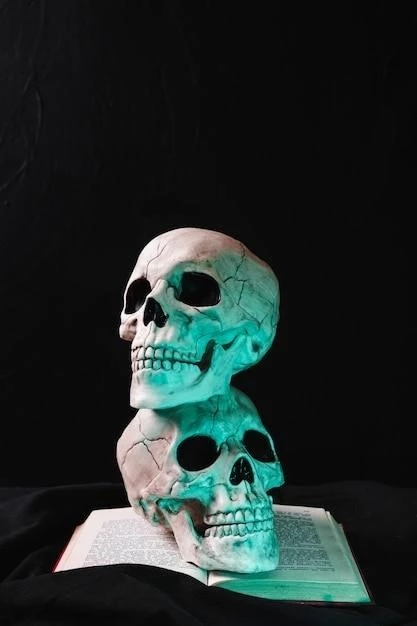Understanding the causes behind Cloverleaf Skull Bone Dysplasia is crucial for effective management․
Causes of Cloverleaf Skull Bone Dysplasia
Cloverleaf Skull Bone Dysplasia is primarily caused by mutations in the FGFR2 gene‚ affecting cranial development․ The specific mechanisms leading to this condition involve abnormal growth of skull bones‚ resulting in the characteristic cloverleaf shape․ These mutations disrupt the normal signaling pathways that regulate bone growth‚ leading to the distinct features seen in affected individuals․ While the exact trigger for these mutations is not always clear‚ genetic factors play a significant role․ Understanding these genetic abnormalities is essential in diagnosing and managing Cloverleaf Skull Bone Dysplasia․
Symptoms and Diagnosis of Cloverleaf Skull Bone Dysplasia
The symptoms of Cloverleaf Skull Bone Dysplasia include a cloverleaf-shaped head‚ bulging eyes‚ high forehead‚ and a prominent skull․ Individuals may also experience neurological complications due to increased intracranial pressure․ Diagnosis involves physical examination‚ imaging studies like CT scans‚ and genetic testing to confirm the presence of FGFR2 mutations․ Early detection is crucial for timely intervention to address associated health issues and plan appropriate treatment strategies․
Treating Cloverleaf Skull Bone Dysplasia
Effective treatment options focus on managing symptoms and addressing complications․
Treatment Options for Cloverleaf Skull Bone Dysplasia
Treatment for Cloverleaf Skull Bone Dysplasia is primarily focused on managing symptoms and associated complications․ Surgical interventions may be necessary to relieve intracranial pressure‚ correct skull deformities‚ and address any neurological issues․ Additionally‚ therapies to support developmental delays and educational interventions may be recommended to improve quality of life and functional outcomes for individuals with this condition․ A multidisciplinary approach involving specialists like neurosurgeons‚ geneticists‚ and therapists is typically utilized to provide comprehensive care․
Outlook for Cloverleaf Skull Bone Dysplasia Patients
Understanding the prognosis and life expectancy is crucial for patient care․
Prognosis and Life Expectancy of Cloverleaf Skull Bone Dysplasia
The prognosis for individuals with Cloverleaf Skull Bone Dysplasia varies depending on the severity of symptoms and the presence of associated complications․ Early diagnosis and intervention play a significant role in improving outcomes and quality of life․ While the condition can present challenges‚ advancements in medical care and surgical techniques have positively impacted the prognosis for affected individuals․ Regular monitoring and multidisciplinary care can enhance life expectancy and overall well-being for those with Cloverleaf Skull Bone Dysplasia․
Exploring Genetic Factors
Understanding the genetic components is key in addressing Cloverleaf Skull Bone Dysplasia․
Genetic Factors in Cloverleaf Skull Bone Dysplasia
Cloverleaf Skull Bone Dysplasia is predominantly linked to mutations in the FGFR2 gene‚ disrupting normal cranial development․ These genetic alterations lead to the characteristic skull abnormalities seen in affected individuals․ Understanding these genetic factors is crucial for accurate diagnosis‚ genetic counseling‚ and personalized treatment strategies․ Research into the specific genetic mechanisms underlying this condition continues to provide valuable insights into potential targeted therapies and intervention approaches․ Ongoing genetic studies play a vital role in advancing our knowledge of Cloverleaf Skull Bone Dysplasia and improving patient outcomes․

Advancements and Support
Discover the latest research progress and available assistance for Cloverleaf Skull Bone Dysplasia․
Research Advances in Cloverleaf Skull Bone Dysplasia
Ongoing research into Cloverleaf Skull Bone Dysplasia focuses on identifying new treatment modalities and understanding the underlying genetic complexities better․ Recent advancements include the exploration of targeted therapies that aim to correct bone abnormalities and alleviate associated symptoms․ Collaborative efforts between researchers‚ clinicians‚ and geneticists are essential in developing innovative approaches to manage this condition․ Stay informed about the latest breakthroughs in Cloverleaf Skull Bone Dysplasia research to support improved care and outcomes for affected individuals․
Support and Resources for Individuals with Cloverleaf Skull Bone Dysplasia
Individuals living with Cloverleaf Skull Bone Dysplasia can benefit from various support services and resources tailored to their needs․ Support groups‚ counseling‚ and specialized care centers offer emotional assistance and practical guidance․ Additionally‚ educational resources‚ financial aid programs‚ and advocacy organizations play a crucial role in providing comprehensive support to both patients and their families․ Accessing these resources can enhance overall well-being and empower individuals affected by Cloverleaf Skull Bone Dysplasia to navigate their unique challenges with confidence․
Preventive Measures
Exploring strategies to potentially prevent Cloverleaf Skull Bone Dysplasia․
Prevention Strategies for Cloverleaf Skull Bone Dysplasia
As Cloverleaf Skull Bone Dysplasia is primarily genetic‚ prevention strategies focus on genetic counseling for families at risk of passing on the condition․ Comprehensive genetic testing and counseling can help individuals make informed decisions about family planning‚ reducing the likelihood of the condition being passed on to future generations․ Continued research into the genetic factors involved in Cloverleaf Skull Bone Dysplasia is essential for advancing prevention strategies and ultimately reducing the prevalence of this rare congenital disorder․
